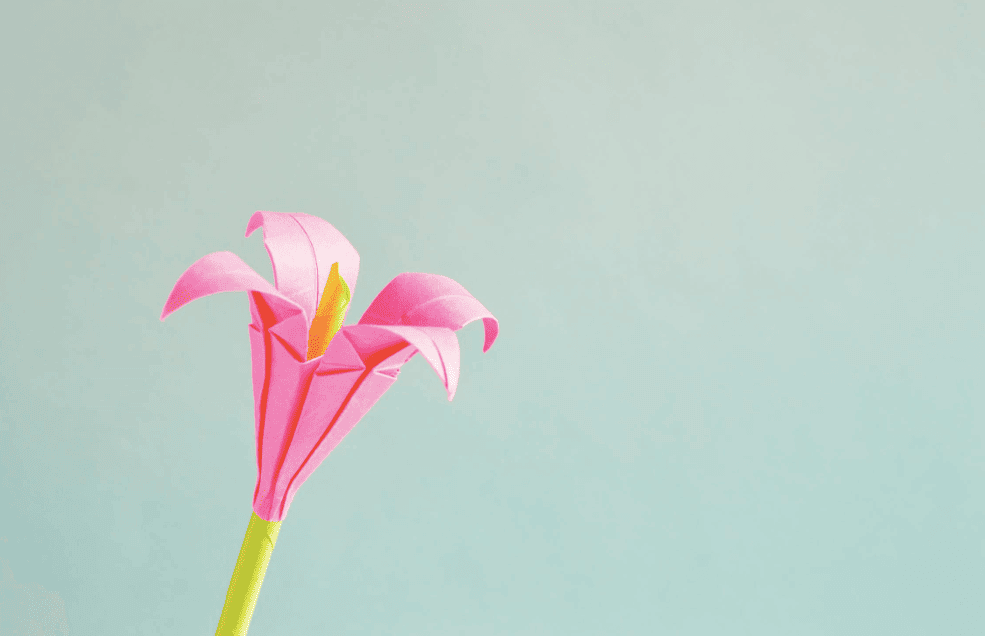
To some, origami may seem like a complex or even confusing art. Others may consider it little more than an activity for children. Throughout the history of origami, it’s been both!
Do you remember sitting down in school and folding a piece of paper into an airplane?
Or perhaps you were one of the unlucky students who was hit in the head by one of the flying paper projectiles (Don’t look at me! I didn’t do it!).You’re probably wondering:“What does that have to do with origami?”
Well, if you have ever seen one, or folded one, of those airplanes, then you can understand the basics of origami.
This history of this ancient art is fascinating. Origami is so much more than just paper folding for children.
Where did it come from? How did it get to be the art it is today?
An Introduction to Origami
“The possibility of creation from [a] paper is infinite.” – Akira Yoshizawa
Origami is the practice of folding paper. You’re probably thinking, origami is one of those ancient arts, whose secrets are passed down from generation to generation of masters.
But you’d be wrong.
While traditionally a Japanese art, the history of origami crosses the world. It traces its roots to China, to Japan, and even to Germany.
Origami does follow a standard set of patterns. But that system is less than 100 years old. Each design uses the same key, so the skills a beginner uses are the same that an expert craftsman does.
Origami’s simplicity, beauty, and accessibility make it a favorite hobby, as well as a versatile art form. Understanding the history of origami helps us see how it can bridge such a wide gap, and see how it became what it is today.
The History of Origami
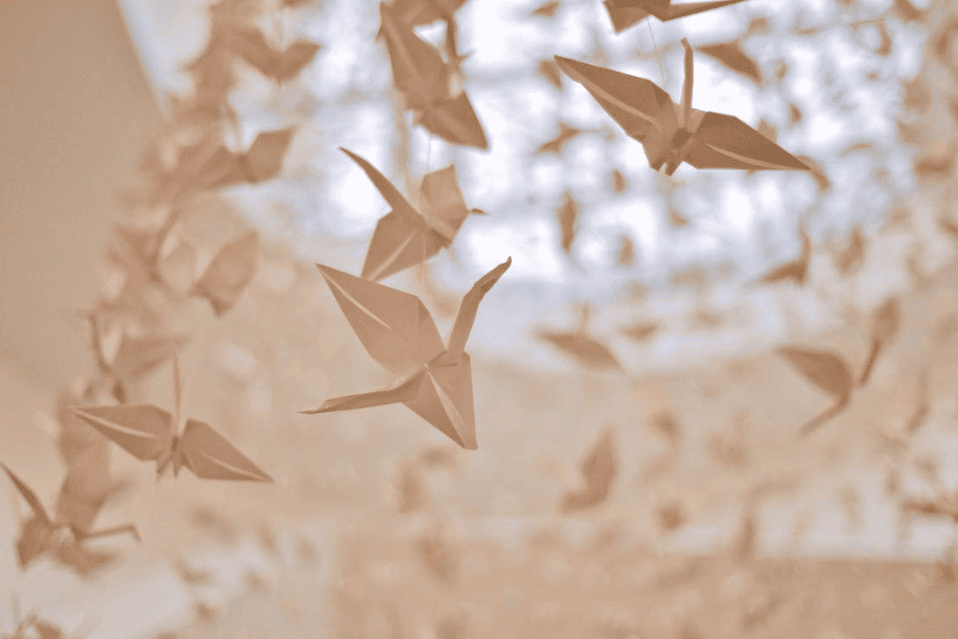
Paper cranes hang from strings in a gallery; Pexels License, by David Yu, via Pexels
The history of origami stretches back almost 2,000 years. Although origami is a Japanese word — and indeed origami is best known as a Japanese art form — it was actually a cultural export to Japan from China around the 1st century C.E. (common era).
In China, folding the paper has long been a tradition for ceremonial purposes.
First-century Chinese people burned paper folded to represent gold ingots as an offering to the dead, and this practice continues today. These ceremonial roots took origami to Japan, where it was practiced by Buddhist monks.
In the early first millennium C.E., the paper was expensive and only available to the elite, such as monks. However, in the 1600s, the Edo period in Japan, feudal lords expanded the local industry. As this included paper making, the paper became much more available.
At that time, however, the paper was still a luxury product.
Although no longer limited to lords and monks, origami was not the childhood craft we see today. It was used primarily for the purpose of gift giving and ceremony.
The first known origami pieces are a pair of folded butterflies used as decoration at a wedding.
As origami grew in popularity, its name actually changed. It was first known as “orikata,” or “folded shapes.”
In 1880, the name was changed to origami, or “folded paper.”
The spread of origami across the world
Even though origami is closely associated with Japan, modern origami is actually a mixture. Its origins have one foot in European education systems.
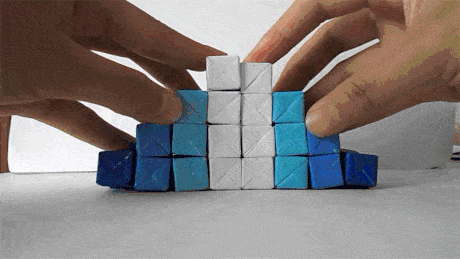
At the same time as origami started growing more popular in Japan, schools in Germany were using folding paper to teach geometry to their students. While not as explicitly artistic as that which came from Japan, German paper folding spread across the world.
It used simpler 45-degree angles, which was easier for children.
The German style of paper folding made its way back to Japan. In fact, modern origami is a mixture of this and the traditional Japanese style.
Now, origami is available to everyone, in large part due to the contributions of Akira Yoshizawa. Yoshizawa helped standardize the patterns which made origami accessible worldwide.
Origami Trivia
Origami: Oru – “to fold” + Kami – “paper”
The origami crane
If not for the humble paper airplane, the origami crane would likely be the most-folded piece in the history of origami.
In fact, the oldest known book of origami is focused entirely on the paper crane. It’s not only an icon of the craft itself. The crane is a touchstone in the history of origami, and the history of Japan in the 20th Century.
Learn how to make one below:
The crane is a revered animal in Japanese folklore. It represents good fortune and was thought to carry souls to heaven.
Tradition indicates that folding 1,000 paper cranes would grant a wish. This tradition gained awareness in the 1950s with the story of Sadako Sasaki. Sadako was a twelve-year-old girl suffering from leukemia as a result of the atomic bomb dropped on Hiroshima. She made it her mission to fold 1,000 paper cranes, and wish to survive her cancer. Sadly, she only folded 644 before her death.
After Sadako’s death, news of her efforts spread. Now, thousands upon thousands of paper cranes decorate her memorial. These wreaths of paper cranes, or senbazuru, fulfilled Sadako’s wish even after her death. Sadako’s story had farther reaching consequences than she may have ever hoped. Her story has become one of peace and healing for Japan and the international community. It’s a reminder of the human cost of war, and also the intense power of hope.
Traditional and Modern Origami as Art
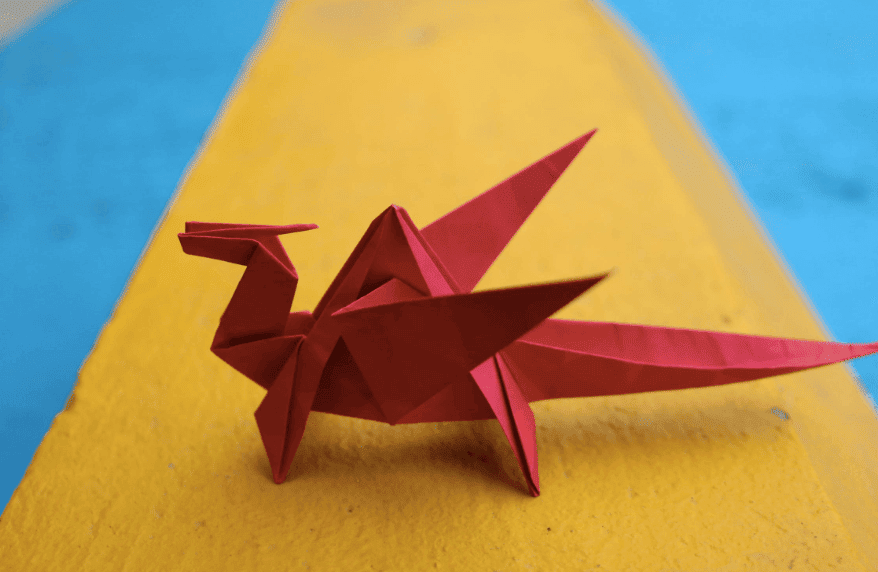
Throughout the history of origami, folders have treated it as a traditional craft, a ceremonial offering, and a fun hobby. But origami is also considered a delicate and beautiful form of art.
Traditional origami art
Naturally, the art of origami is somewhat transient. Paper is not the easiest to preserve. Pieces made in the past were not made to last for centuries.
You already know that some pieces of folded paper were burned as offerings. Others were used in ceremonial rites, while others still were used as decoration.
However, it was not considered a serious art form until the 1950s. Because of this, little if any origami from before the 20th Century is still around today. But wait, there’s more:
Origami fun fact:
Sadako Sasaki and her cranes continue to inspire peace and cooperation in international relations. Her cranes have been donated to monuments such as the 9/11 memorial in New York, in her memory. The simple craft of origami has inspired many to seek peaceful solutions and offer healing to others.
Modern origami art
The same cannot be said of origami in the modern day. Various new folding techniques and materials, as well as preservation tools, makes origami a more permanent art form. Because of the very pliable nature of paper, origami artists are constantly pushing the envelope in fascinating ways.
Many artists are taking origami to amazing heights. Some create organic curves, fractals, and spheres. Others are going bigger, such as by creating life-sized elephants out of single sheets of paper.
“I felt that origami, just folding, was too restricted… I thought that I should challenge origami, particularly the geometrical constraint.” – Jun Mitani
Even more, artists are folding different materials than paper, to amazing effect. While some artists see sheets of paper as a canvas, for origamists the paper is the medium. Like a palette of paint, there are endless possibilities in a sheet of paper.
All it takes is a creative mind to fold them into being.
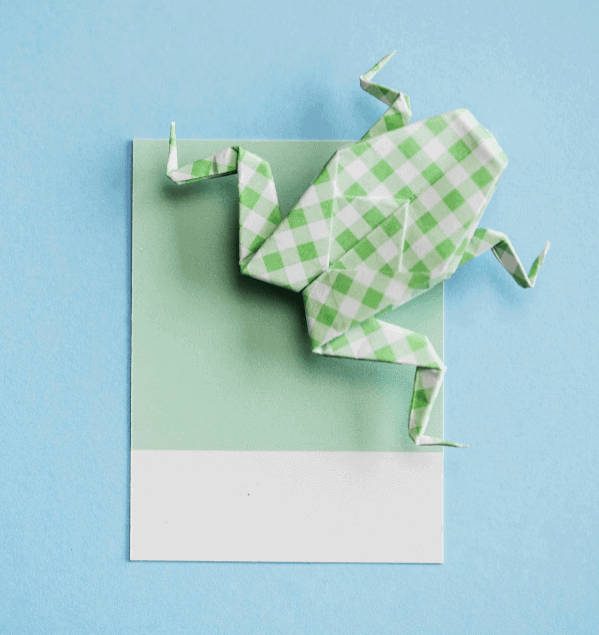
Notable Origamists that You Should Know
Because origami was the realm of monks and hobbyists before the 1900s, there are no notable folders before that time. Since origami has become a more respected form of art, folders are gaining renown as artists.
Remember these names:
Akira Yoshizawa
One of the most important figures in the history of origami is Akira Yoshizawa. Known as the “Grandmaster of Origami,” Yoshizawa became interested in the craft at a young age. As a young man, his job was to teach factory employees geometry. Following the German example, Yoshizawa turned to origami.
Just before World War II, he left his job to focus on origami full-time. It took nearly 15 years to pay off. But after a commission from a magazine to fold the animals of the zodiac, Yoshizawa earned his fame and reputation.
Yoshizawa took the craft from an activity for children into a serious art form. One of his widest-reaching contributions to origami is the notation system which nearly all folders use today.
This notation uses a simple combination of dotted or dashed lines to indicate how to fold the paper. It also uses arrows to show you when to fold or flip your origami.
Yoshizawa also pioneered wet-folding, which allows more organic curves than dry paper. He made advancements in origami both as an activity for anyone to partake in and as a form of high art.
In a way, by making origami accessible to everyone, Yoshizawa ensured its survival. Once origami was no longer just a hobby for children, it was fertile ground for experimentation by artists. He is responsible for nearly every origamist who practices or has practiced, today.
In addition to inventing the notation system for origami, the notation also bears his name. The Yoshizawa-Randlett system has made origami accessible and easy for millions of folders across the world.
Robert J. Lang
Throughout the history of origami, geometry has played a central role. It continues to do so today, with mathematicians using paper to create complex forms. Robert J. Lang, a mathematician, and lifelong origamist, is one such artist.
By combining two of his passions, Lang has been able to create fascinating and lifelike works of origami. At the same time, he has used the principles of origami to further his scientific research.
Lang focuses on the intersection of science and art. He says that math is intimately tied to his art, and it defines what he can do with paper. When Lang is struck by an idea for a new piece, he turns to mathematics for help.
Origami also works the other way around. Lang has used origami to inform how to fold structures such as solar panels for spacecraft. These need to be compact on launch but unfold once in space. Mathematical models have helped Lang and his collaborators further the art of origami, taking it from a children’s hobby to scientific pursuit.
How Origami Can Enrich Your Life
No, really.
Origami is much more than just an aesthetic process.
While origami can create beautiful works of art, it can also help people learn, or become more relaxed.
Origami can help children learn
The history of origami is inextricably tied with education. It was an education that brought paper folding to Europe. It was also education which inspired Akira Yoshizawa to use origami in his work.
Origami is useful as a teaching tool for geometry, of course. But there is also a basis in using the art for early childhood brain development.
Cognitive skills and motor skills are shown to develop together in early childhood. The parts of the brain which control these two areas are closely related. When a child refines their motor skills through origami, they are also exercising their cognitive center.
By this relationship, a simple and fun activity such as origami can become very important to development. That’s not all:
Origami also helps children learn and understand many more advanced concepts. In addition to geometry, origami teaches children visualization and problem-solving.
While origami notation is easy to learn, it can still be a bit confusing at times. Being able to visualize how a project will turn out is an essential skill later in life.
Children can also learn how to fix their mistakes. Imprecision can quickly ruin a project. Being able to go back and see where they went wrong, and fix them, can make kids more willing to fail.
This lets them learn from their mistakes to succeed in the future.
Origami can help adults curb anxiety
Origami’s positive effects don’t stop at childhood; adults can gain from the practice as well.Many origamists are promoting the craft as a way to achieve mindfulness.
Mindfulness is the act of being more aware of the present moment. It encourages you to be accepting of the things around you, rather than try and change them or tune them out. The peaceful and methodical act of folding paper helps some people reach this.
While mindfulness is not a concrete concept, its practice can be beneficial. Analysis of mindfulness research showed a potential relationship between mindfulness practices and stress reduction.
Origami asks you to focus on the present moment, on being precise and patient with your process. It asks adults to deal with failure in the same healthy way that it does of children.
While origami may not have proven psychological benefits, it has a chance to help with your stress. You may just find yourself connecting with the present moment more.
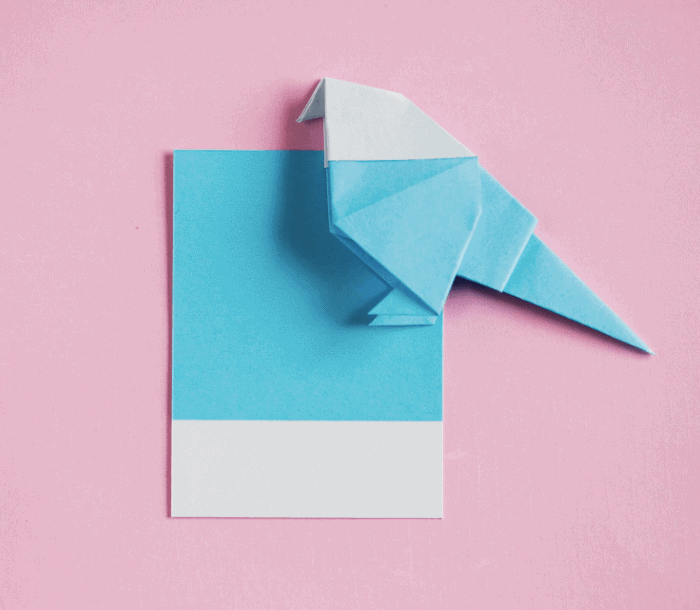
History of Origami: To Make Art, You Must Know the Basics
The history of origami is both broad and deep. But for all of the art’s history, the actual practice is very simple.
You can learn to fold in an hour or less, with nothing more than a square of paper and some simple patterns.The core of origami is, of course, the fold.
There are a few different types of folds, mostly depending on whether the crease faces towards or away from you. In order to streamline the process, there are also several base folds. Any practiced origamist should have the base folds ready in their mind.
The bases form the first few steps of a lot of origami patterns.
Here’s what you need to know:
Origami folds you must master
The two core folds of origami are the mountain fold and the valley fold. Simply put, a mountain fold crease towards you, while a valley folds creases away. Watch the video below to learn how to do them:
Every other aspect of origami comes from those folds. Many common “folds” are compounds of these two base folds.
For example, folds like the rabbit ear fold give you a flap of paper which can go in either direction. Others, like the squash fold, require a bit of finesse and skill. However, all of these folds become commonplace after the most basic patterns.
Similarly, how you maneuver the paper can be complex. Origami notation includes directions for how to rotate and flip the paper. Sometimes, the combination of arrows and dashes can be confusing. Coupled with the more complex folds, it’s easy to see how an origamist can make a mistake even on a relatively simple project.
The most important thing is to be patient and learn what each symbol means. By doing this, you can quickly progress towards complex patterns. Look:
Base patterns for origami
Origami, like any other craft, has a set of core skills which you should master before moving on to more complex items.
If folds and flips are the musical notes of origami, then bases are your scales.
Nearly every pattern starts with one of these bases, and each of them exercises core origami skills:
- Kite base
- Fish base
- Bird base
- Preliminary base
- Blintz base
- Windmill base
Learning these by heart will not only help you fold faster but better as well.
The necessary origami paper and materials
If you’ve ever folded origami before, you’re probably familiar with kami. Thin, brightly-colored kami squares are the least expensive and most common type of origami paper.
Surprisingly, kami is not the traditional paper used in origami. It actually shows up relatively late in the history of origami. Kami is best for hobbyists and beginners, but it is cheap and does not hold its shape over time. In fact, the best origamists don’t even use kami.
Traditionally, origami was made with Japanese washi paper.
This paper has a history almost as old as the history of origami. Artisans make washi paper by hand, and it has myriad uses beyond origami. Decorated with bright patterns, washi paper becomes chiyogami. Chiyogami’s intricate designs are vibrant and unique. They make for striking pieces of origami.
Well-known origamists, from Yoshizawa to artists living today, are always experimenting with new materials. Some folders use foil-backed paper to help models keep their shape. Others work with completely different materials like Tyvek, for greater durability.
Yoshizawa pioneered the use of wet-folding paper. It becomes malleable when wet and strong when dry. This lets origamists use curved folds and achieve greater precision on their sculptures.
As the art form of origami evolves, so will the material that both artists and hobbyists use.
Yes, There Are Other Forms of Origami
Pure origami has vast possibilities, as shown by the works of artists such as Robert J. Lang. Working with just one piece of paper, you can still push the boundaries of what is possible.
But many folders want to push beyond even the limits of one piece of paper.
Wet-folding is interesting
Wet-folding, as has been mentioned, was developed by Akira Yoshizawa. This type of folding uses a more durable type of paper. This paper includes a component called sizing. Sizing strengthens the paper after it dries.
Check out wet-folding below:
Using damp paper gives you more room for expression, according to Lang. It makes for organic curves and precise folds. Wet-folding holds its shape better, especially for things like insect legs. Where dry paper may spring back, the wet-folded paper will dry in place.
Pureland origami
Pureland origami is a derivative of pure origami. In addition to not allowing glue or scissors, Pureland only uses mountain and valley folds. This makes Pureland easier to fold for people with disabilities.
Some folders see Pureland as an additional challenge. It is a way of creating designs out of only the simplest processes.
Learn how to make a Pureland bear below!
It gets better:
Street origami
The history of origami has taken the art from ceremonial practice to commonplace hobby. So, it’s no surprise that many have started folding with whatever they have on hand. Two particularly popular types are dollar and chopstick wrapper origami.
In Japan, many diners fold origami out of their chopstick wrappers. One Japanese waiter began to see these pieces of art as a sort of tip and started collecting them. Diners would fold their wrappers into cranes, fish, and other designs.
Dollar bills and other currency are also popular for origami. A dollar can be folded into as many different objects as a square of paper can. This includes koi fish and dragons.
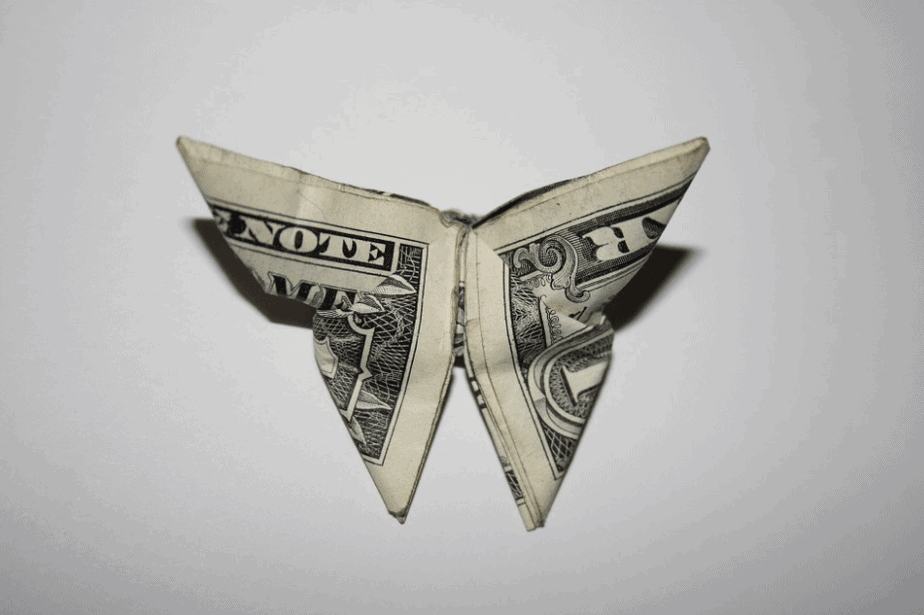
A dollar bill butterfly; Pixabay License, by jordandemuth, via Pixabay
People use chopsticks wrappers in similar ways and fashion origami out of them. But wait, there’s still more:
Non-origami paper folding
There are many other forms of paper folding that do not fall under origami. They involve cutting and gluing or folding multiple pieces of folded paper together.
One form of paper folding that may be confused with origami is Golden Venture folding. This type of folding involves using the same shape repeatedly and combining them into larger figures.
Folders use this method to create elaborate models, although they often lack the lifelike nature of advanced origami. Unlike origami, the shapes do not come explicitly from folding the paper.
Another type of paper folding is papercraft. Papercrafters do this by printing out patterns onto sturdy paper, like cardstock. Then, they cut out, fold, and glue together the patterns.
Papercraft is popular for things like costume building. The patterns are sturdier than origami, and makers can reinforce them against wear and tear.
Peering into the Future of Origami
The history of origami stretches back for two millennia. But most of the significant progress origami has seen has only been in the past few centuries. Whether it was by the advent of cheap paper in Japan or the efforts of one origami lover, origami has seen a sudden rise in popularity.
Through the past 100 years, origami has become a method of folding foil, cloth, and even solar panels. This deceptively simple art has rapidly pushed forward. Its practitioners will continue to advance origami to places that are as-yet unpredictable.





